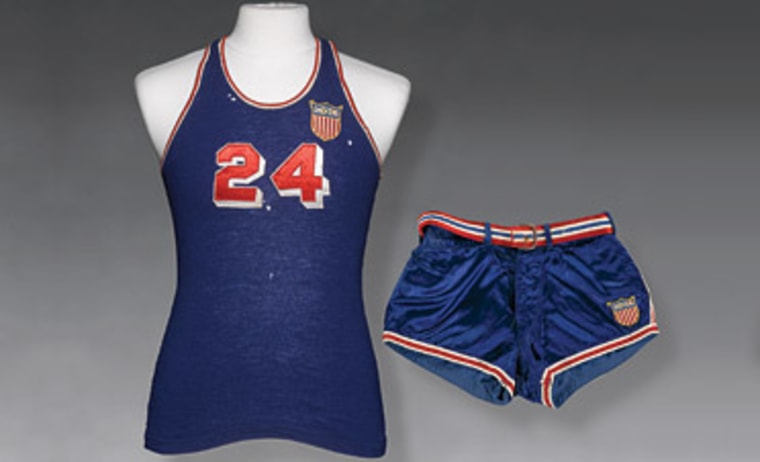When it comes to the Summer Olympics, not everyone is monitoring swimmers' times and cyclers' speeds — or even China's air quality and human-rights record. Some are keenly scanning the landscape for items they can add to their Olympic memorabilia collections.
They're scoping out the expected volumes of tacky, mascot-bearing trinkets — from key chains to Coca-Cola cans — and the furiously traded official stamps and pins that have been around since the first modern Olympics were conducted in 1896. But the most discerning among them are waiting for the greatest spoils: the truly valuable artifacts like athlete's gold medals, worn jerseys, and even torches that will eventually start appearing on the market.
"You can bet that collectors will be in Beijing ready to buy directly from athletes as soon as they win," says Ingrid O'Neil, a Vancouver-based dealer in sports and Olympic memorabilia. "Items will start showing up for sale in a few months." When she set up shop at the International Olympic Committee's store during the Salt Lake City Olympics in 2002, athletes came in to unload medals and uniforms. "Many of them can use the extra money," says O'Neil, who is currently offering "participation medals" — given to every athlete who shows up at the games — from Berlin in 1936, Mexico City in 1968, and Barcelona in 1992 for about $300.
Crazed for torches
When Olympic fever hits, interest in collectibles surges, and older items start recirculating. Often the material is discovered languishing in basements by heirs, as was the case with sprinter Eddie Tolan, who in 1932 became the first African American to win two gold medals. "We got a call from a family member in Michigan, and she had his medals, uniform and an incredible collection of his personal memorabilia," says Doug Allen of Chicago's Mastro Auctions. Sometimes a specific collector drives a surge. "There was a buyer a few years ago who caused a craze because he wanted to collect all of the Olympic torches," continues Allen. "Suddenly the things were coming out of the woodwork."
Torches, used in the around-the-world relays leading up to the event, are currently the most sought-after of higher-end Olympic collectibles. "They're aesthetically pleasing and very specific to the event," Allen says. The 1984 torch, for example, is made of brass-finished aluminum with a tan leather handle and depicts the L.A. Coliseum, while 1992's stainless-steel, flame-shaped Albertville torch has the added cachet of having been designed by Philippe Starck.
Prices for torches usually fall into the $5,000 to $7,000 range, but can exceed that depending on how many were produced. In 2006, according to O'Neil, a 1952 Helsinki torch — of which only 22 were made — sold privately for $185,000. By contrast, this year's relay, which ends this week in Beijing after four months, involved a record 20,000-plus torches. Usually runners keep their torches, but China has taken its flames back. O'Neil posits that since the government has retained control over the torches, they won't be as hot a collectible as in the past. "The Chinese will surely release them into the market," O'Neil says, "but they'll never reach the prices of previous torches."
Medal mania
While few objects rival torches in covetability, medals certainly come close. Victors' medals sell for thousands of dollars; in 2006, O'Neil sold a gold from the St. Louis games for $49,000. Even certain participation medals can go as high as $20,000 if they are from those same St. Louis games. Rarity is a key factor: In 1904, only 651 athletes participated in the games; this year, nearly 11,000 athletes will compete.
Provenance does sometimes come into play; clothing worn by winners, for example, is extremely popular. In June 2007, Sotheby's auctioned off seven jerseys belonging to players on America's 1992 basketball "Dream Team" for $10,800. Imbued with history — the team, which included Charles Barkley and Magic Johnson, was the first to appear after a rule change allowed professionals to play in the Olympics — as well as sweat, the uniforms represent the ultimate acquisition for collectors. Items with a specific, compelling story top a specific year or city, Allen says. As with any Olympic collectible, "much of the value has to do with the performance that the athlete or team had."
The big names don't come up all that often, though. "Dorothy Hamill and Mark Spitz have no financial need to sell their stuff," Allen points out. But celebrities do donate items to fundraisers, and those things can trickle into the marketplace. Down-on-their-luck stars also sell their wares. A few years ago, Mastro auctioned Mike Tyson's boxing trunks and robe from his (failed) 1984 Olympics tryout for more than $10,000, and skater Tonya Harding made headlines when word got out that she was unloading her closet of costumes in the mid-1990s. An eBay seller is currently auctioning one of her (non-Olympic) outfits for $5,000.
It's too soon to tell which athletes' belongings will have legs this year, and experts certainly don't put much stock in the heaps of official goods. "They'll make great mementos, but they won't appreciate," says Allen of the record 300 products Beijing has licensed to help offset its (also record) $40 billion in infrastructure and organizational costs. Indeed, thousands of Olympic pins, stamps, postcards, and Coca-Cola cans are available on eBay — from games past and present — for less than $20. And while ticket stubs from the storied 1980 "Miracle on Ice" U.S. versus Soviet Union hockey game can fetch $500, game ephemera, too, is best tucked away with your photo albums.
A smarter strategy: Keep your eyes peeled for material from the 1908 or 1948 London Olympics. As the 2012 games near, prices are sure to jump.
